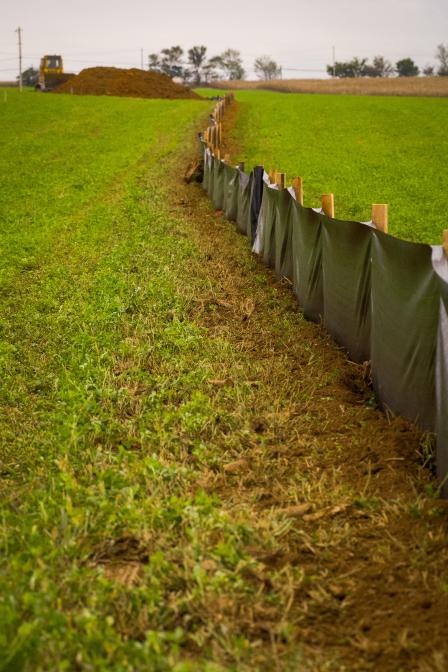Source Water Protection Practices
Source water protection practices are actions taken to prevent contamination of surface and groundwater sources of drinking water. In choosing protection practices, water systems and government officials should account for the types of contaminant threats, physical landscape properties, public input, and other site-specific factors identified during the assessment process.
General Protection Practices
 Conserving wetlands in source water protection areas can help protect water quality, recharge aquifers, and maintain surface water flow during dry periods. Wetlands also provide important fish and wildlife habitat. Communities utilize a combination of regulatory and voluntary approaches to address threats to their drinking water supply. Given that source water protection is not required in most localities and that water utilities cannot regulate their source watersheds, approaches that complement a broad sweep of community objectives, whether protection of water quality, open space, or disaster resilience may receive more widespread public support and participation. Examples of source water protection practices include:
Conserving wetlands in source water protection areas can help protect water quality, recharge aquifers, and maintain surface water flow during dry periods. Wetlands also provide important fish and wildlife habitat. Communities utilize a combination of regulatory and voluntary approaches to address threats to their drinking water supply. Given that source water protection is not required in most localities and that water utilities cannot regulate their source watersheds, approaches that complement a broad sweep of community objectives, whether protection of water quality, open space, or disaster resilience may receive more widespread public support and participation. Examples of source water protection practices include:
- Land use controls (such as zoning ordinances and growth controls)
- Regulations, permits, and inspections
- Land conservation and "natural infrastructure" solutions
- Best management practices
- Public education and outreach
- Cost share programs and financial incentives
- Hazard mitigation
Source-Specific Protection Practices
The links below provide information on common sources of contamination and the practices used to prevent and mitigate the impacts of pollution from those sources.
 Erosion and sediment control measures help prevent sediment, chemicals, and nutrients from washing off construction sites and into lakes, rivers, and streams that serve as drinking water sources.Crop Agriculture
Erosion and sediment control measures help prevent sediment, chemicals, and nutrients from washing off construction sites and into lakes, rivers, and streams that serve as drinking water sources.Crop Agriculture- Animal Agriculture
- Septic Systems
- Urbanization & Stormwater Runoff
- Chemical Storage Tanks (Above- and below-ground storage tanks)
- Forestry
- Industrial Wastewater
- Abandoned Mines
Clean Water Act Tools for Source Water Protection
The Clean Water Act establishes the basic structure for regulating quality standards for surface water and discharges of pollutants into the waters of the United States. Given that the Safe Drinking Water Act (SDWA), which sets standards for the quality of drinking water delivered to customers, does not establish authority for protecting drinking water sources, the Clean Water Act provides the primary regulatory tool for protecting source water quality. Federal, tribal, and state water program managers and the public all play a role in ensuring that Clean Water Act programs are adequately protective of drinking water supplies. A number of Clean Water Act "tools" can be used to protect drinking water resources. Examples include:
- The National Pollutant Discharge Elimination System (NPDES): Set effluent limits on discharges of pollutants that are regulated as drinking water contaminants under the Safe Drinking Water Act
- Water Quality Standards (WQS): Establish WQS with criteria for regulated drinking water contaminants for waters designated for drinking water supply
- Impaired Waters and Total Maximum Daily Loads (TMDLs): Prioritize development of TMDLs and 319 restoration funds for source waters that fail to meet WQS
Clean Water Act-Safe Drinking Water Act Integration Resources:
- Opportunities to Protect Drinking Water and Advance Watershed Goals Through the Clean Water Act: A Toolkit for State, Interstate, Tribal and Federal Water Program ManagersExit: A collaboration between EPA and state water quality managers across clean water and safe drinking water programs, this toolkit highlights specific Clean Water Act provisions and tools and describes how Clean Water Act and Safe Drinking Water Act program staff and managers can more routinely coordinate activities to achieve important drinking water and watershed protection goals
- From Source to Tap: How to use the Clean Water Act to protect sources of drinking waterExit: The Source Water Collaborative developed this interactive infographic as a public-facing companion to “Opportunities to Protect Drinking Water and Advance Watershed Goals Through the Clean Water Act: A Toolkit for State, Interstate, Tribal and Federal Water Program Managers." Source to Tap provides tips and strategies for leveraging Clean Water Act public participation opportunities to protect sources of drinking water.
